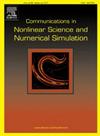Stabilization of nonlinear Timoshenko system just with local damping and local coupling effects acting on arbitrarily chosen subintervals
IF 3.4
2区 数学
Q1 MATHEMATICS, APPLIED
Communications in Nonlinear Science and Numerical Simulation
Pub Date : 2025-02-26
DOI:10.1016/j.cnsns.2025.108721
引用次数: 0
Abstract
We are concerned with the stabilization of nonlinear Timoshenko system just with local damping and local coupling effects, which come from the local memory/frictional terms and local coupling terms, acting on arbitrarily chosen subintervals. Especially, the subintervals do not necessarily include the ends and intersect each other, unlike what is usually required. For this challenging problem, we successfully establish a stability theorem with the exact uniform decay rates for the solutions to this system with the help of some specially designed analysis approaches for the problem. Also, polynomial/exponential decay rates are obtained, when the memory kernels decay polynomially/exponentially. Our results reveal an important phenomenon that for the nonlinear Timoshenko system, local coupling and damping effects are enough to produce an entire dissipation mechanism as those for the case of the global coupling and damping effects, and the same decay rates can be obtained. Moreover, under quite weak conditions on the memory kernels, our stability theorem gives stronger conclusions than the previous corresponding results, whether global or local memory effect is concerned.
求助全文
约1分钟内获得全文
求助全文
来源期刊

Communications in Nonlinear Science and Numerical Simulation
MATHEMATICS, APPLIED-MATHEMATICS, INTERDISCIPLINARY APPLICATIONS
CiteScore
6.80
自引率
7.70%
发文量
378
审稿时长
78 days
期刊介绍:
The journal publishes original research findings on experimental observation, mathematical modeling, theoretical analysis and numerical simulation, for more accurate description, better prediction or novel application, of nonlinear phenomena in science and engineering. It offers a venue for researchers to make rapid exchange of ideas and techniques in nonlinear science and complexity.
The submission of manuscripts with cross-disciplinary approaches in nonlinear science and complexity is particularly encouraged.
Topics of interest:
Nonlinear differential or delay equations, Lie group analysis and asymptotic methods, Discontinuous systems, Fractals, Fractional calculus and dynamics, Nonlinear effects in quantum mechanics, Nonlinear stochastic processes, Experimental nonlinear science, Time-series and signal analysis, Computational methods and simulations in nonlinear science and engineering, Control of dynamical systems, Synchronization, Lyapunov analysis, High-dimensional chaos and turbulence, Chaos in Hamiltonian systems, Integrable systems and solitons, Collective behavior in many-body systems, Biological physics and networks, Nonlinear mechanical systems, Complex systems and complexity.
No length limitation for contributions is set, but only concisely written manuscripts are published. Brief papers are published on the basis of Rapid Communications. Discussions of previously published papers are welcome.
 求助内容:
求助内容: 应助结果提醒方式:
应助结果提醒方式:


